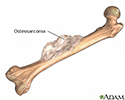Osteitis fibrosa
Osteitis fibrosa cystica; Hyperparathyroidism - osteitis fibrosa
Osteitis fibrosa is a complication of hyperparathyroidism , a condition in which certain bones become abnormally weak and deformed.
Hyperparathyroidism
Hyperparathyroidism is a disorder in which the parathyroid glands in your neck produce too much parathyroid hormone (PTH).

Causes
The parathyroid glands are 4 tiny glands in the neck. These glands produce parathyroid hormone (PTH). PTH helps control calcium, phosphorus, and vitamin D levels in the blood and is important for healthy bones.
Too much parathyroid hormone (hyperparathyroidism) can lead to increased bone breakdown, which can cause bones to become weaker and more fragile. Many people with hyperparathyroidism develop osteoporosis. Not all bones respond to PTH in the same way. Some develop abnormal areas where the bone is very soft and has almost no calcium in it. This is osteitis fibrosa.
In rare cases, parathyroid cancer causes osteitis fibrosa.
Symptoms
Osteitis fibrosa may cause bone pain or tenderness. There may be fractures (breaks) in the arms, legs, or spine, or other bone problems.
Hyperparathyroidism itself may cause any of the following:
- Nausea
- Constipation
- Fatigue
- Frequent urination
- Weakness
Exams and Tests
Blood tests show a high level of calcium, parathyroid hormone, and alkaline phosphatase (a bone chemical). Phosphorus level in the blood may be low.
X-rays may show thin bones, fractures, bowing, and cysts . Teeth x-rays may also be abnormal.
Cysts
A cyst is a closed pocket or pouch of tissue. It can be filled with air, fluid, pus, or other material.
Teeth x-rays
Dental x-rays are a type of image of the teeth and mouth. X-rays are a form of high energy electromagnetic radiation. The x-rays penetrate the body...
A bone x-ray may be done. People with hyperparathyroidism are more likely to have osteopenia (thin bones) or osteoporosis (very thin bones) than to have full-blown osteitis fibrosa.
Bone x-ray
A bone x-ray is an imaging test to look at the bones.

Osteoporosis
Osteoporosis is a disease in which bones become fragile and more likely to break (fracture).

Treatment
Most of the bone problems from osteitis fibrosa can be reversed with surgery to remove the abnormal parathyroid gland(s). Some people may choose not to have surgery, and instead be followed with blood tests and bone measurements.
If surgery is not possible, medicines can sometimes be used to lower calcium level.
Possible Complications
Complications of osteitis fibrosa include any of the following:
- Bone fractures
- Deformities of bone
- Pain
-
Problems due to hyperparathyroidism, such as
kidney stones
and
kidney failure
Kidney stones
A kidney stone is a solid mass made up of tiny crystals. One or more stones can be in the kidney or ureter at the same time.
 ImageRead Article Now Book Mark Article
ImageRead Article Now Book Mark ArticleKidney failure
Acute kidney failure is the rapid (less than 2 days) loss of your kidneys' ability to remove waste and help balance fluids and electrolytes in your b...
 ImageRead Article Now Book Mark Article
ImageRead Article Now Book Mark Article
When to Contact a Medical Professional
Call your health care provider if you have bone pain, tenderness, or symptoms of hyperparathyroidism.
Prevention
Routine blood tests done during a medical checkup or for another health problem usually detect a high calcium level before severe damage is done.
References
Silverberg SJ, Bilezikian JP. Primary hyperparathyroidism. In: Jameson JL, De Groot LJ, de Kretser DM, et al, eds. Endocrinology: Adult and Pediatric . 7th ed. Philadelphia, PA: Elsevier Saunders; 2016:chap 63.
Thakker RV. The parathyroid glands, hypercalcemia and hypocalcemia. In: Goldman L, Schafer AI, eds. Goldman's Cecil Medicine . 25th ed. Philadelphia, PA: Elsevier Saunders; 2016:chap 245.
-
Bone tumor - illustration
An abnormal growth of cells within the bone that may be benign or malignant (cancerous).
Bone tumor
illustration
-
Parathyroid glands - illustration
The 4 parathyroid glands are located near or attached to the back side of the thyroid gland and produce pararthyroid hormone (PTH). Parathyroid hormone regulates calcium, phosphorus, and magnesium balance within the blood and bone by maintaining a balance between the mineral levels in the blood and the bone.
Parathyroid glands
illustration
-
Bone tumor - illustration
An abnormal growth of cells within the bone that may be benign or malignant (cancerous).
Bone tumor
illustration
-
Parathyroid glands - illustration
The 4 parathyroid glands are located near or attached to the back side of the thyroid gland and produce pararthyroid hormone (PTH). Parathyroid hormone regulates calcium, phosphorus, and magnesium balance within the blood and bone by maintaining a balance between the mineral levels in the blood and the bone.
Parathyroid glands
illustration
Review Date: 5/2/2016
Reviewed By: Brent Wisse, MD, Associate Professor of Medicine, Division of Metabolism, Endocrinology & Nutrition, University of Washington School of Medicine, Seattle, WA. Also reviewed by David Zieve, MD, MHA, Isla Ogilvie, PhD, and the A.D.A.M. Editorial team.


